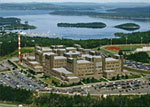Saint John Regional Hospital to Get First PET/CT Scanner in Atlantic Canada
by
Michael Johns, Project Manager | June 13, 2006

Atlantic Canada to obtain PET/CT;
money being raised
By Erin Barnes
Eight diagnostic tests in 14 days. That is what a New Brunswick retired teacher had to endure several years ago as physicians searched for the primary site of her malignant melanoma. When this testing still did not produce the answers they needed, they progressed with available options - interferon, chemotherapy and more. When she completed her course of treatment, the patient decided to launch her own investigations about her cancer. As a result of that research, she began questioning her oncologists about having a PET/CT scan. The closest available equipment was located in Sherbrooke, Quebec, so she made the trip and underwent a scan. In October 2001, she received the "all clear" and her husband says, "she enjoyed the first good night's sleep in two years." One scan - versus the dozens of invasive tests and treatments - has given her the same all clear results several times since.
Convinced of the benefit of this technology, the Government of New Brunswick has approved the operation of a PET/CT diagnostic scanner at Atlantic Health Sciences Corporation (AHSC). The Saint John Regional Hospital Foundation, has launched a campaign to raise the $4.5 million necessary to purchase and install the powerful PET/CT scanner at the hospital. The technology merges Positron Emission Tomography with Computed Tomography (PET/CT). This effort will bring to the Saint John Regional Hospital a technology that represents a giant leap forward in terms of diagnostic capability and monitoring of treatment effectiveness. Specifically, the PET/CT's vivid and highly precise images will help ensure earlier, more accurate diagnoses, more effective treatment and care, and enhanced learning and research capability.
Positron Emission Tomography (PET) uses low grade radioactive material that is injected into a patient's blood stream to study the function of an organ or tissue. For cancer studies, glucose is combined with the radioactive material. The glucose concentrates in areas of high metabolism - cancer tumours. When a PET scan is completed, a highly defined image is produced and any tumours literally "light up." A PET scan in combination with a CT scan, further illustrates the tumour and the precise location is shown in an astoundingly accurate image. The combined imaging allows physicians to locate, assess and study tissue and organ functioning at a cellular level with incredible precision.
Dr. Brian Wheelock, AHSC Chief of Medical Staff indicates that "the truly amazing images possible with a PET/CT scan will change the way we practice medicine and have a significant impact on patient care." Lives will be saved as a result of earlier and more precise diagnoses and, as a result, New Brunswickers will benefit from more effective treatments and care. As an example, the percentage of sensitivity in assessing lung cancer with a CT scan alone is 57 per cent but when combined with a PET scan, the percentage of sensitivity reaches 84 per cent. Incredibly in assessing breast cancer recurrence, the percentage of sensitivity using only a CT scan is 56%, but when combined with a PET scan, the percentage is 100 per cent. Because of the remarkable accuracy in determining a malignant or benign growth and in identifying its precise location and spread, the PET/CT technology is used for oncology purposes more than 70% of the time.
